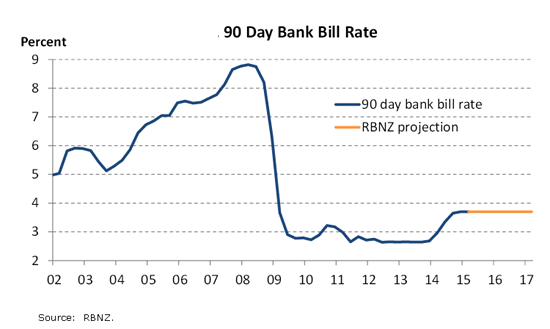
Is there a vigorous internal debate going on at the Reserve Bank of New Zealand (RBNZ) over the direction of the next Official Cash Rate (OCR) move?
Yes, according to Christian Hawkesby, a director and head of fixed interest and economics at Harbour Asset Management.
"We believe that the RBNZ’s forecast for a flat interest rate track masks a vigorous internal debate about the direction of the next OCR move, where there are strong offsetting forces at play.
On the one hand, strong business and consumer confidence, and housing market strength, point to an OCR hike, whereas the high NZ dollar, low inflation and low inflation expectations, all
point to the need for a lower OCR," Hawkesby, who has previously worked for both the RBNZ and Bank of England, says in Harbour's latest fixed interest monthly commentary.
The RBNZ's next OCR review is due on April 30. After four increases last year, with a combined 100 basis points added between March and July, the OCR is currently at 3.50%. RBNZ Governor Graeme Wheeler ultimately makes the decisions over whether the OCR is increased, reduced or left unchanged.
In its most recent Monetary Policy Statement, on March 12, the RBNZ forecast the 90 day bank bill rate would remain unchanged at 3.7% until March 2017 suggesting there'll be no move in the OCR for some time. This forecast was a significant change from December when the RBNZ forecast the 90 day rate would rise to 4.5% by the end of 2017.
"We interpret the RBNZ’s flat 90 day rate track as signifying a high degree of uncertainty, and therefore a high hurdle to move one way or other. We suspect that the direction of the next move in the OCR may depend on timing," adds Hawkesby.
"If the RBNZ do not move until 2016 or 2017, in our opinion, the next move is most likely to be up, as they gain confidence about the strength of the NZ economy, deflation fears are avoided, and they continue their journey towards a more neutral OCR setting around 4.5%. In this scenario, the US economic expansion continues, and the US Federal Reserve begin their long awaited process of lifting the US fed funds rate, removing US monetary stimulus and strengthen the US dollar."
"By contrast, if the next move in the OCR is in 2015, it is most likely to be to the downside as it would take a larger event to prompt them the RBNZ action in the near term. It is never easy to identify economic surprises, but candidates to watch include a further round of deflation worries in Europe, a return of political turmoil in Greece, a property market correction in China, or further sharp falls in New Zealand’s commodity prices," Hawkesby says.
"Perhaps the most immediate pressure point for the RBNZ is the strength of the NZ dollar, particularly as the currency flirts with parity against the Australian dollar. If the US Federal Reserve was to delays its process for lifting the US fed funds rates, or the Reserve Bank of Australia were to signal the prospect of further rate cuts over the ditch, this could finally tip the RBNZ into action in 2015."
Financial markets are expecting the US Federal Reserve to increase the Federal Funds Rate, currently set at 0% to 0.25%, sometime this year marking the first increase in nine years.
The key fourth prong
Meanwhile, ANZ's economists say they are close to ticking off three of the four prongs needed before OCR cuts become a realistic proposition.
"Given recent dairy price falls, NZ dollar strength, and an expectation the RBNZ will turn to prudential policy with regards to housing, we are now closer to ticking off three of our 'four prongs' needed before OCR cuts become a realistic proposition. Our monthly inflation gauge for March (out Wednesday) will give an idea of the skew of risks surrounding the first quarter consumers price index - subdued core inflation is the fourth and most critical 'prong'," ANZ's economists say in their weekly New Zealand economics market focus report.

3 Comments
It took the GFC and a catastrophic earthquake decimating a major city before the RBNZ were forced to actually drop interest rates in alignment with global conditions and long-suffering mortgage holders.
Australia will be cutting interest rates in May.
The NZ CPI will be near Zero for Q1 in NZ, while the target inflation for the RBNZ is 2%.
Eurozone is in deflation. USA is unlikely to raise rates despite the rhetoric.
Why is it so difficult for NZ to cut interest rates in alignment with general economy conditions?
Does the Auckland housing market now dominate every economic decision?
"Does the Auckland housing market now dominate every economic decision? "
Yes.
As long as the Govt refuses to do anything about the record net migration into AKL, no restrictions on foreign buyers, and tax incentives for landlords; then that situation will contine.
I hope Christian is right, but "vigorous internal debate" is not exactly encouraged at today's Reserve Bank.
For my take on the OCR issue http://croakingcassandra.com/2015/04/20/past-time-to-start-reversing-oc…

We welcome your comments below. If you are not already registered, please register to comment.
Remember we welcome robust, respectful and insightful debate. We don't welcome abusive or defamatory comments and will de-register those repeatedly making such comments. Our current comment policy is here.